It’s no secret that France produces incredible footballers. You need look no further than the last edition of the FIFA World Cup for proof of that, with the likes of Kylian Mbappé and Aurélien Tchouaméni lighting up the tournament. The current crop of talent eligible to play for France is unbelievably skilful — and that doesn’t just go for the senior squad. Throughout all the age groups, squads are brimming with players that will undoubtedly reach fantastic heights in their careers.
In terms of their history in Under-21 tournaments, France actually has a rather chequered history. They won the competition back in 1988 but more recently, after reaching the semi-finals in 2006, Les Bleuets then failed to qualify for the next six U21 European Championship tournaments. After qualifying for the 2019 competition, France reached the semi-finals and then most recently, Sylvain Ripoll’s men reached the quarter-finals in 2021.
The 2023 UEFA European Under-21 Championship is fast approaching and France will be heading into it as one of the favourites. Current manager Sylvain Ripoll has so much talent at his disposal featuring the likes of the ever-talented Enzo Le Feé, much admired Amine Gouiri and man of the moment Bradley Barcola.
This tactical analysis will take the form of a scout report where we will analyse France’s potential squad and starting lineup. We will also dissect the tactics that Sylvain Ripoll has used throughout his reign as Under 21 manager as well as provide an analysis of who we think will be France’s key player during this tournament.
Predicted Starting XI
Predicting the starting XI Sylvain Ripoll is most likely to use is not an easy task. In the last year alone, the former Lorient manager has used four different tactical setups; 4-2-3-1, 4-3-3 and more recently a 4-4-1-1 and a 4-4-2. The majority of the formations used allow for a great deal of flexibility — for example, a 4-4-1-1 can easily become a 4-4-2 and vice versa. Additionally, a 4-2-3-1 very often appears to be a 4-4-2 when the team is pressing as it is much easier to press with two forwards in order to force the opposition into a mistake.
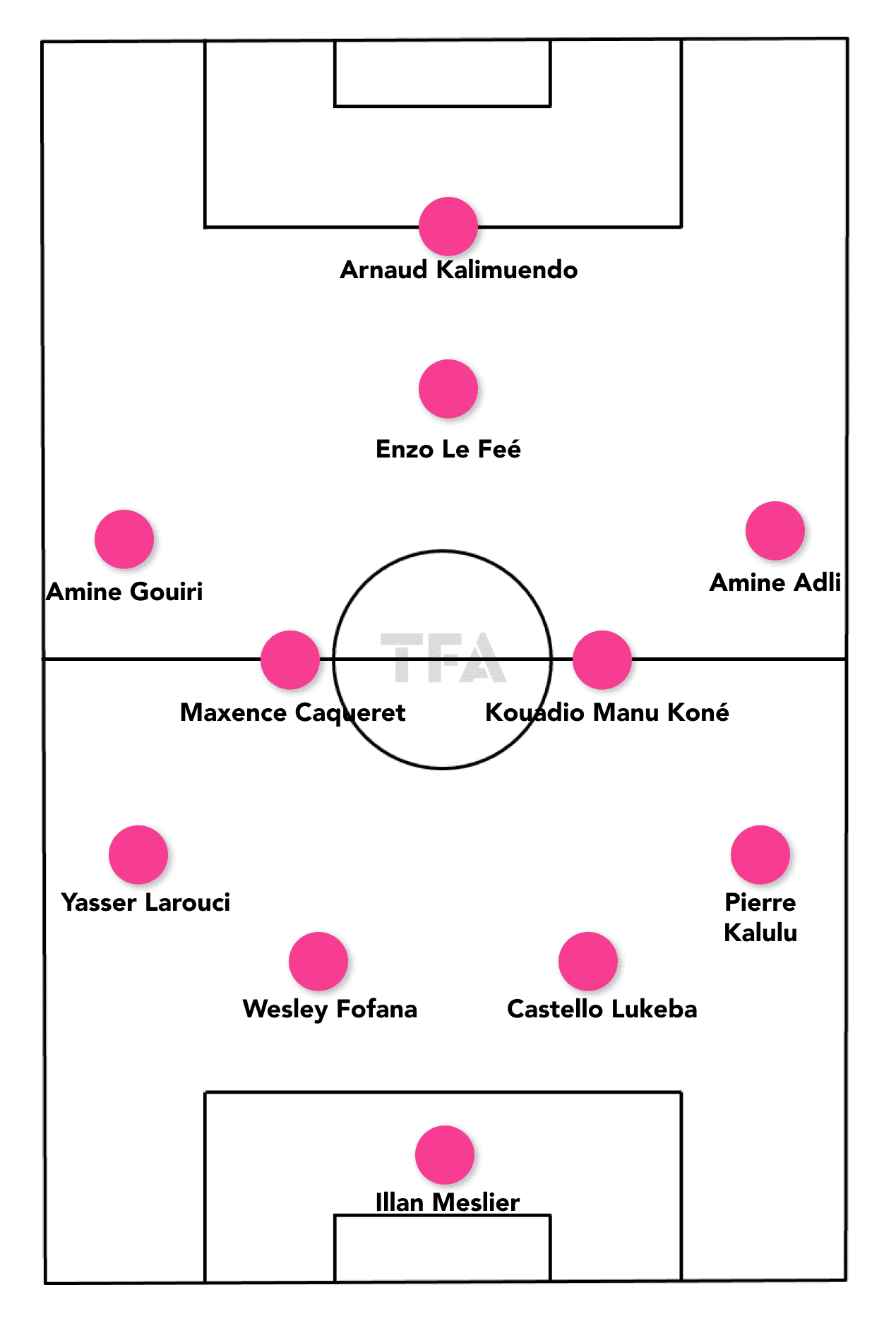
For our predicted XI we have opted for the formation which he has used the most, 4-4-1-1. Ripoll will likely keep the faith in Illan Meslier despite his rather questionable performances for Leeds this season. Yasser Larouci has impressed in recent outings and with Adrien Truffert still working his way back to full fitness, Larouci seems like the more reliable choice at left back. Wesley Fofana and Castello Lukeba are a likely centre-back pairing due to the recent injury to Benoît Badiashile. Pierre Kalulu has made 15 appearances for France U21 so far and has been a consistent performer for AC Milan this season, so he will likely get the nod at right back.
Manu Koné and Maxence Caqueret have been Ripoll’s central midfield pairing of choice on a few occasions and they seem to work well together. Koné, in particular, is a standout player due to his off-the-ball movement and effectiveness in the press. The wingers sort of pick themselves as Amine Gouiri and Amine Adli are both incredible talents — the former has scored 19 goals for France U21 whilst the latter has enjoyed a wonderful season at club level and will be looking to bring that into the tournament.
Enzo Le Feé is undoubtedly someone that Ripoll will ask to provide some creativity as he thrives in the attacking midfield role. Meanwhile, former PSG youngster Arnaud Kalimuendo has had a steady rise, having enjoyed two seasons on loan at Lens and a transfer to Rennes. He is a speedy forward with an eye for goal and has scored four goals for France U21 so far.
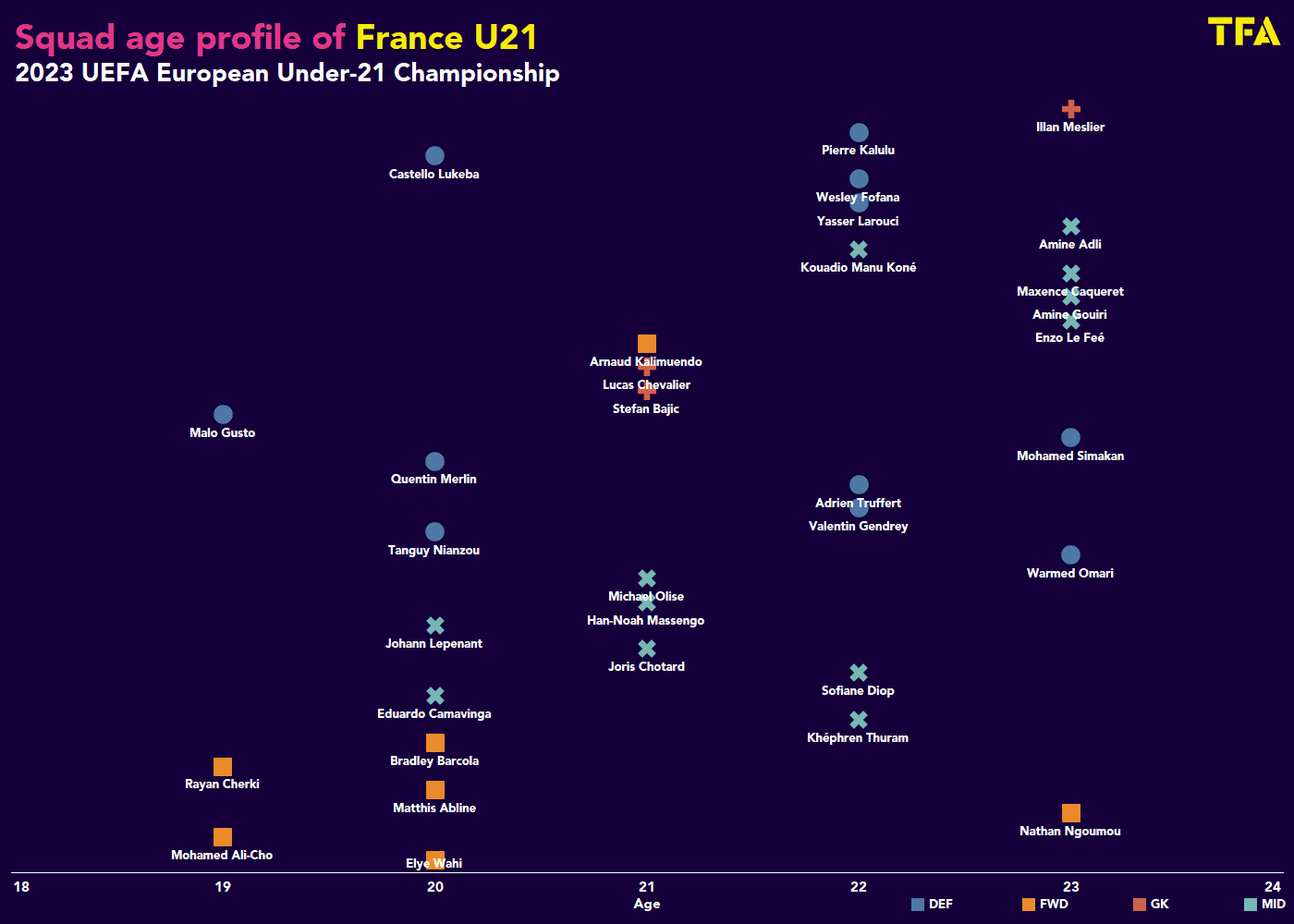
Sylvain Ripoll has several talented players at his disposal which makes predicting his final squad for the Euros rather difficult. Having compiled a list of players who could make the squad we can see that the age range is fairly varied between 19 and 23 years old. These players have a vast amount of experience at their respective clubs and should be able to cope with the level of expectation that will be on them due to the success of the senior team.
Many of the players who have represented France at senior level are also still eligible for the U21 European Championships, however, it is increasingly unlikely that these players will be called up. Edouardo Camavinga played a significant role in France U21’s qualifying for these Euros and he remains eligible for selection but since he has become reasonably established in the senior team, it is probably unlikely he will be selected.
There are some doubts over Malo Gusto and Adrien Truffert who both suffered injuries and whilst they are returning to full fitness, it remains unknown if they will be fit enough for the competition.
Attacking Phase
In this section of the scout report, we will analyse how France performs in the attacking phase of play.
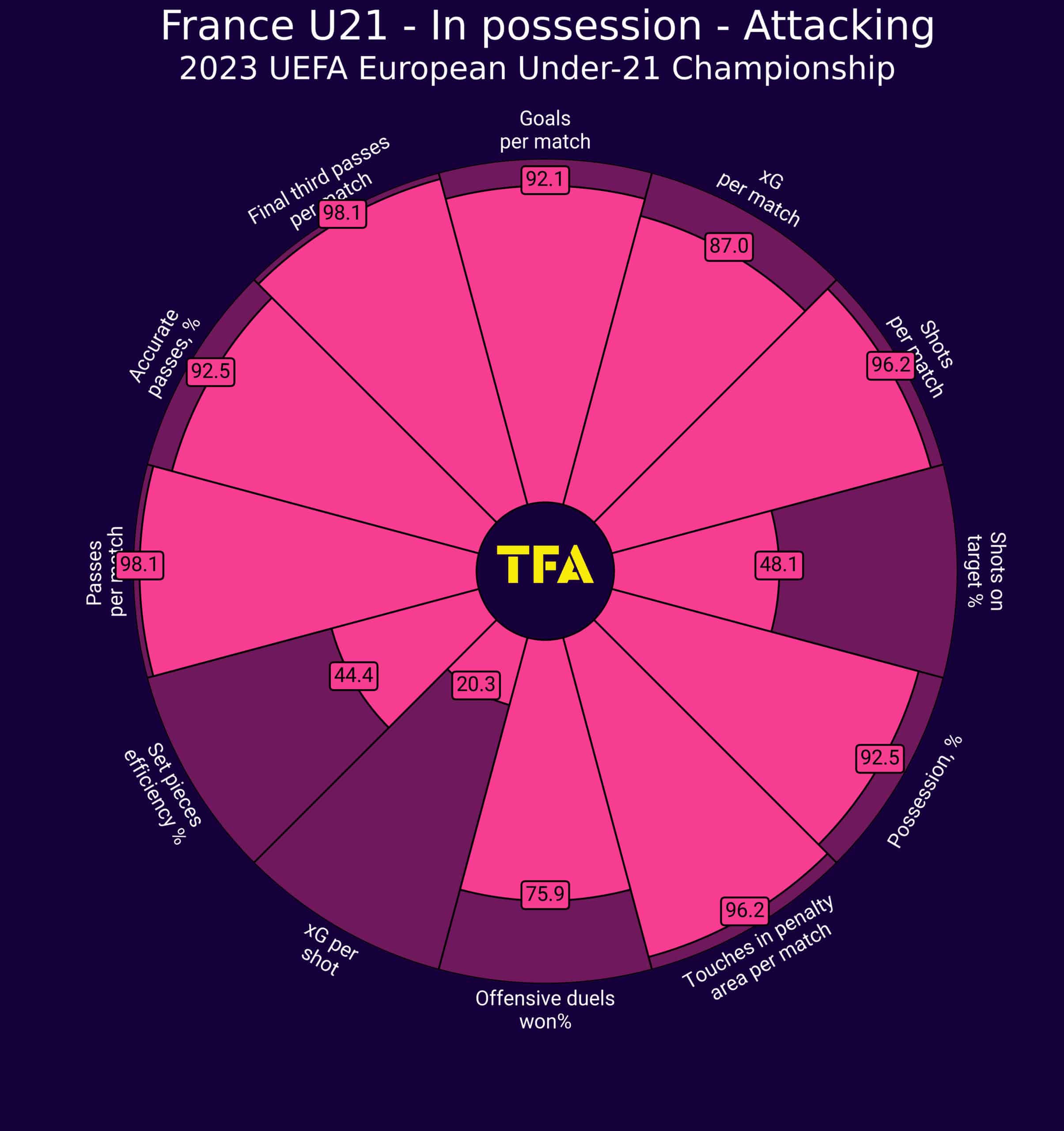
This data visual shows us how well France perform in the attacking phase of play. This squad possesses copious amounts of creativity and that shows through the amount of chances they create per game. However, we can also infer that they are not the most efficient in terms of their shots on target despite having a high number of shots per game.
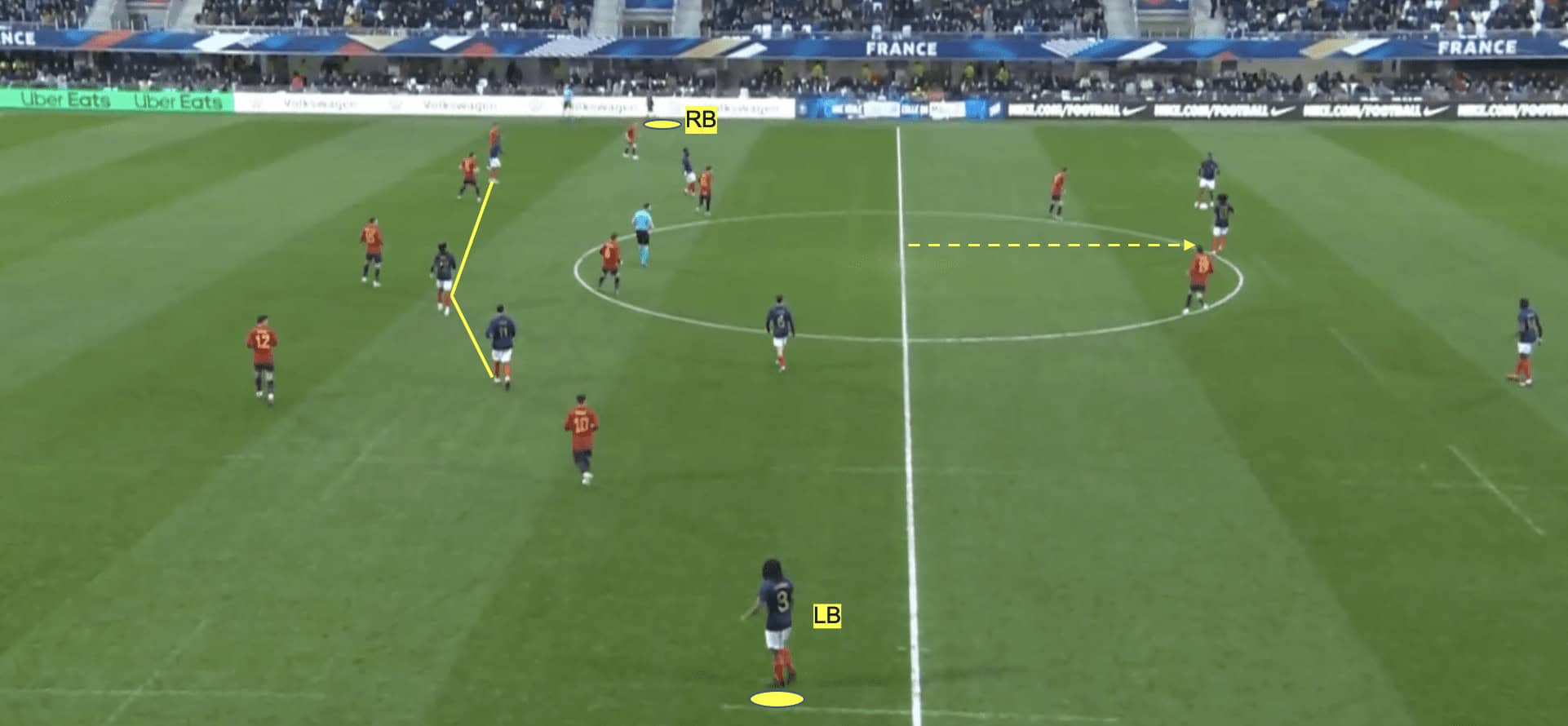
These images are taken from a recent game against Spain where Les Bleuets lined up in a very fluid 4-4-2 formation. We can see that as France looks to build up from the back, their structure takes on more of a 3-4-3 shape, Ripoll asks the full-backs to push up higher whilst one of the central midfielders, Han-Noah Massengo in this example, drops back alongside the two centre-backs.
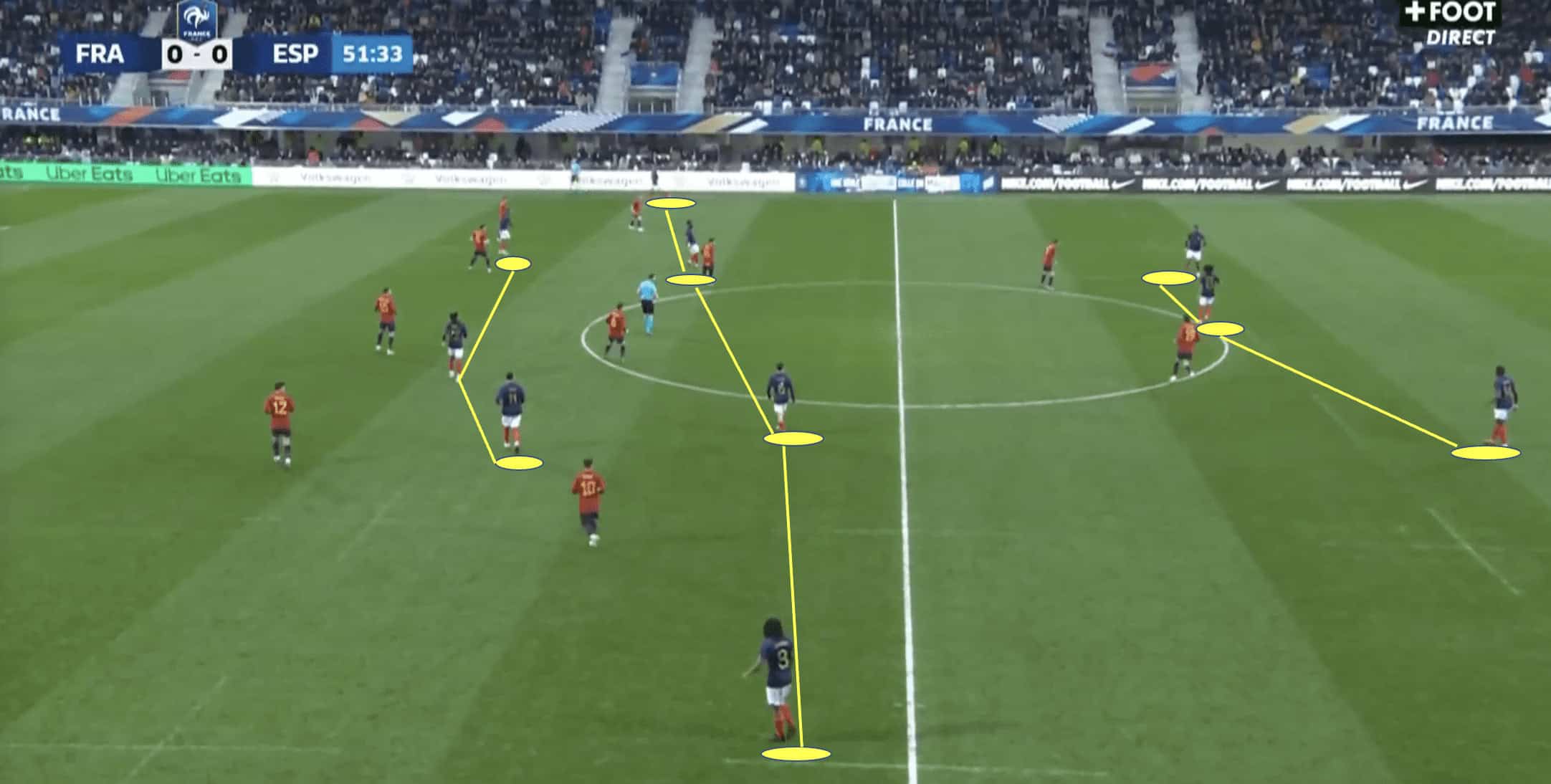
Additionally, the forward who has a slightly freer role, will drop inside and fill in the central midfield area. Meanwhile, Gouiri, who is the left winger in this image, and the right winger, are both tucked inside to form a front three alongside the centre forward.
The 3-4-3 shape is advantageous when building from the back as it combines a solid defensive structure thanks to three players in the defensive line. This means they are able to play around or through an opposition press even if it is led by two forwards. Moreover, the presence of four midfielders in the middle of the pitch allows for greater control and distribution of the ball. This facilitates smooth transitions from defence to attack, as the midfielders can receive the ball from the defenders and distribute it to the attacking players.
Also, due to the attacking potency that France possesses, the three forward players in this scenario means that it becomes challenging for the opposition to mark and contain all of them effectively.
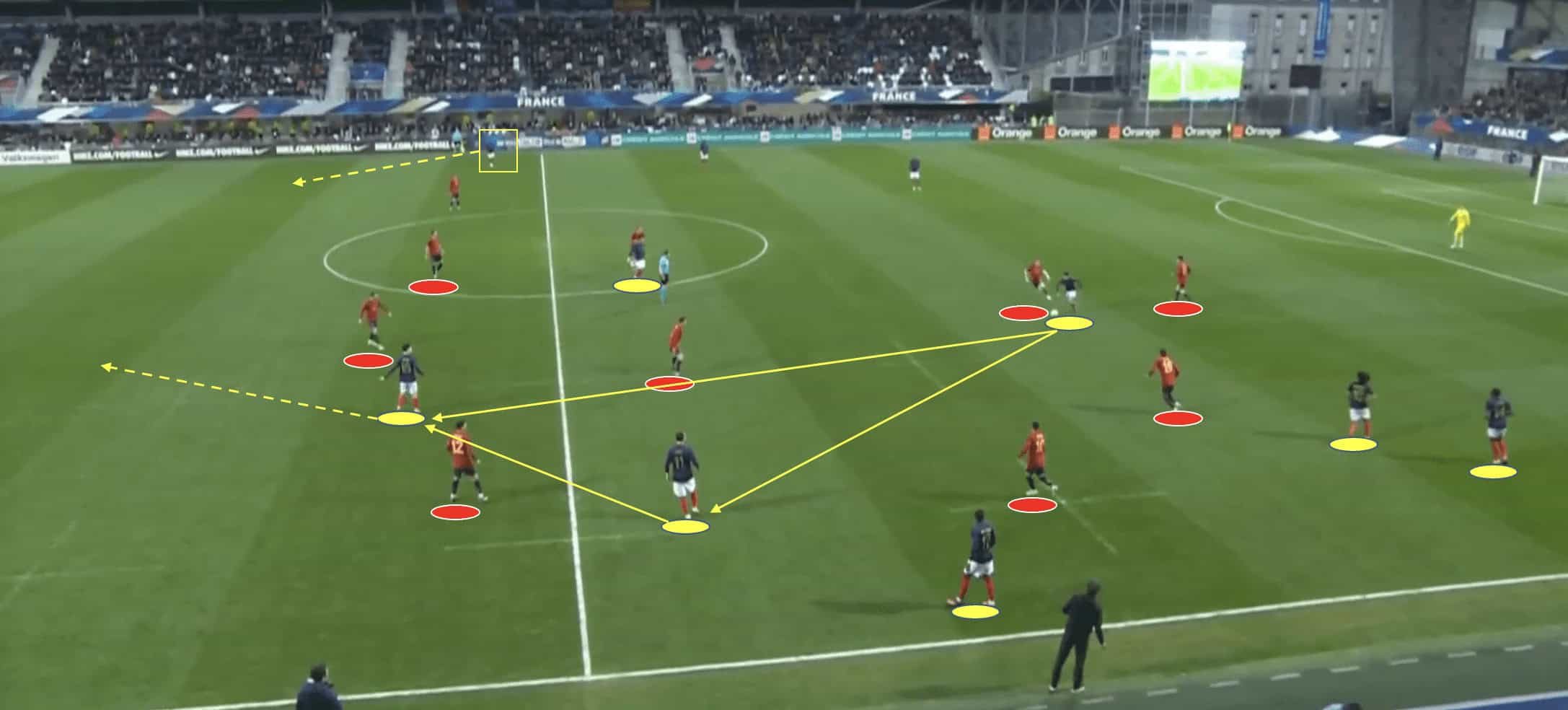
France enjoys drawing their opponents into a press so that they can play through them. The image above demonstrates this, the French team passed the ball back to the defence, baiting Spain into initiating a press. By inviting the opposition to press, France can create space behind the pressing players.
When the opposition commits players forward to press aggressively, gaps can appear in their defensive structure. The team can exploit these spaces by playing quick passes or making penetrating runs, allowing them to bypass the pressing players and advance into the opponent’s territory as shown in the image above. As we can see in the example, space has opened up for attacking players, the forward has the opportunity to run in behind the Spain defensive line which is extremely high due to their desire to press.
Ripoll’s team averages 79.38 progressive passes per 90 and many of them are born out of situations similar to that shown above. We can see that the defender has bypassed the press and now has the opportunity to play a pass straight through to the forward or he can play a pass out wide to Gouiri who can then play in the forward.
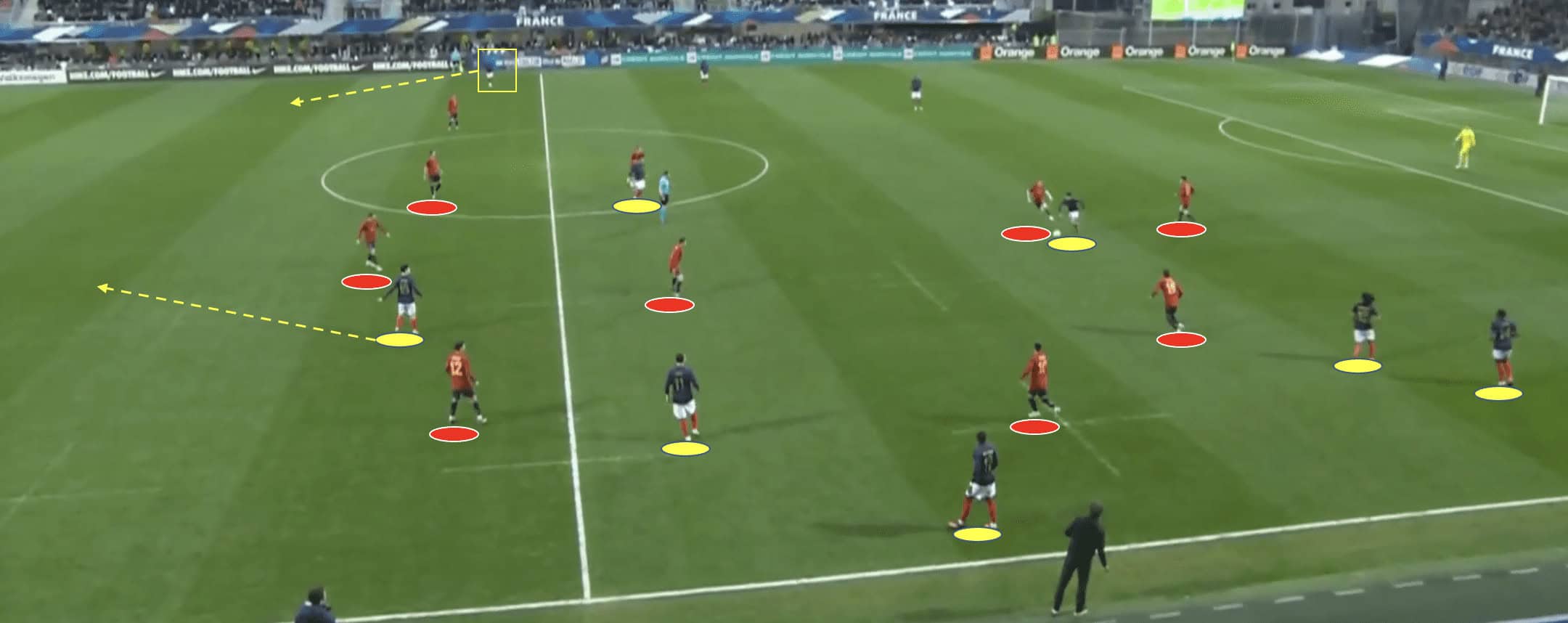
By allowing the opposition to press them, France can create a situation where there is an overload on one side. As shown in the image above, this creates numerical superiority in specific areas of the pitch.
When the attacking team has more players in a specific area, it forces the opposition to shift their defensive focus to that side. So, as France has enticed Spain into a press, it has subsequently meant that more Spanish players have drifted over to their right flank which means there is a vast amount of space on the opposite side for France to potentially exploit.
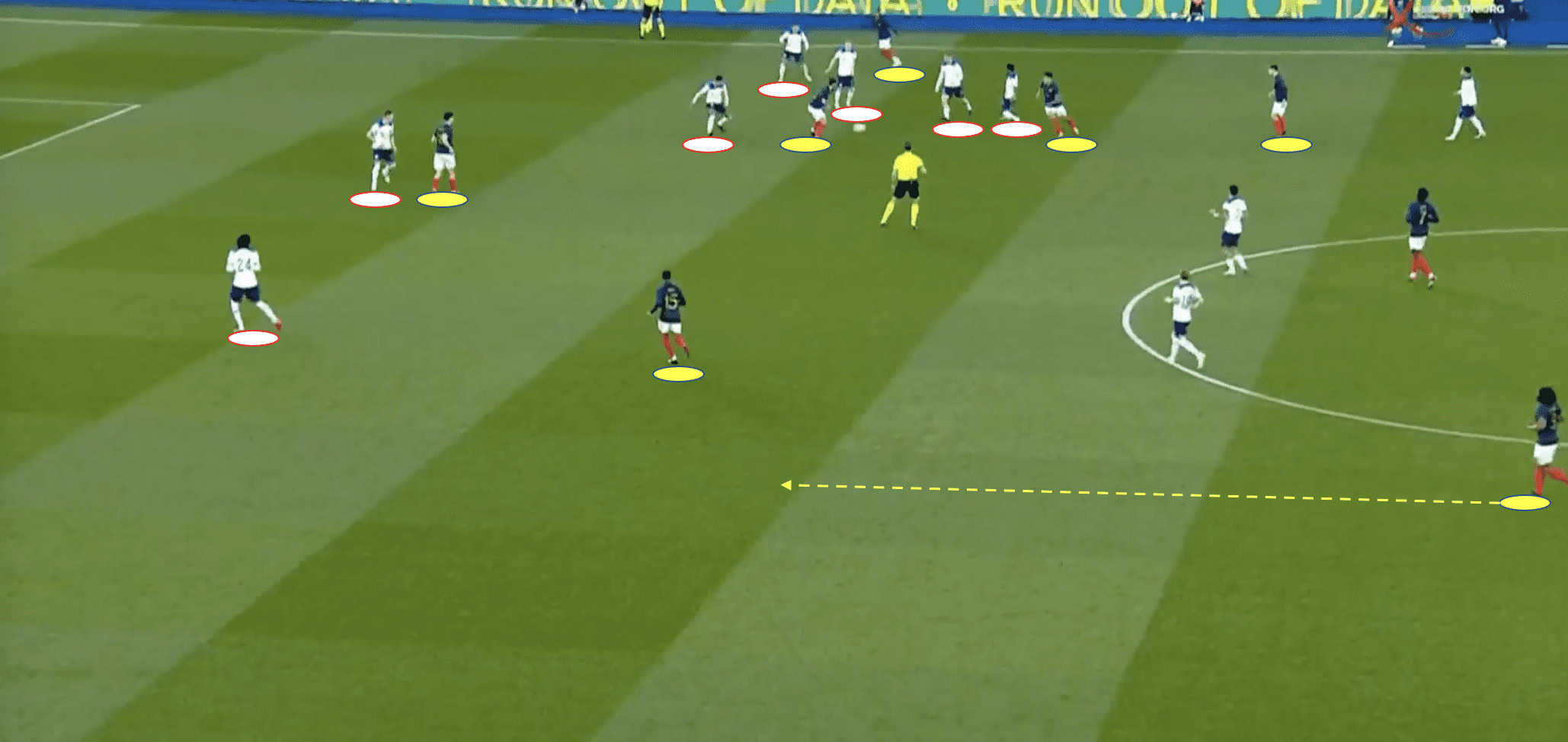
Furthermore, one-sided overloads facilitate quick ball circulation and combination play as we can see in this example. With more attacking players available in the attacking zone, France can quickly move the ball between them, using quick passes and intricate combinations. This has disorientated England’s defence and means that there are spaces available for attackers to quickly turn and lose their marker or for the left back to make a run forward.
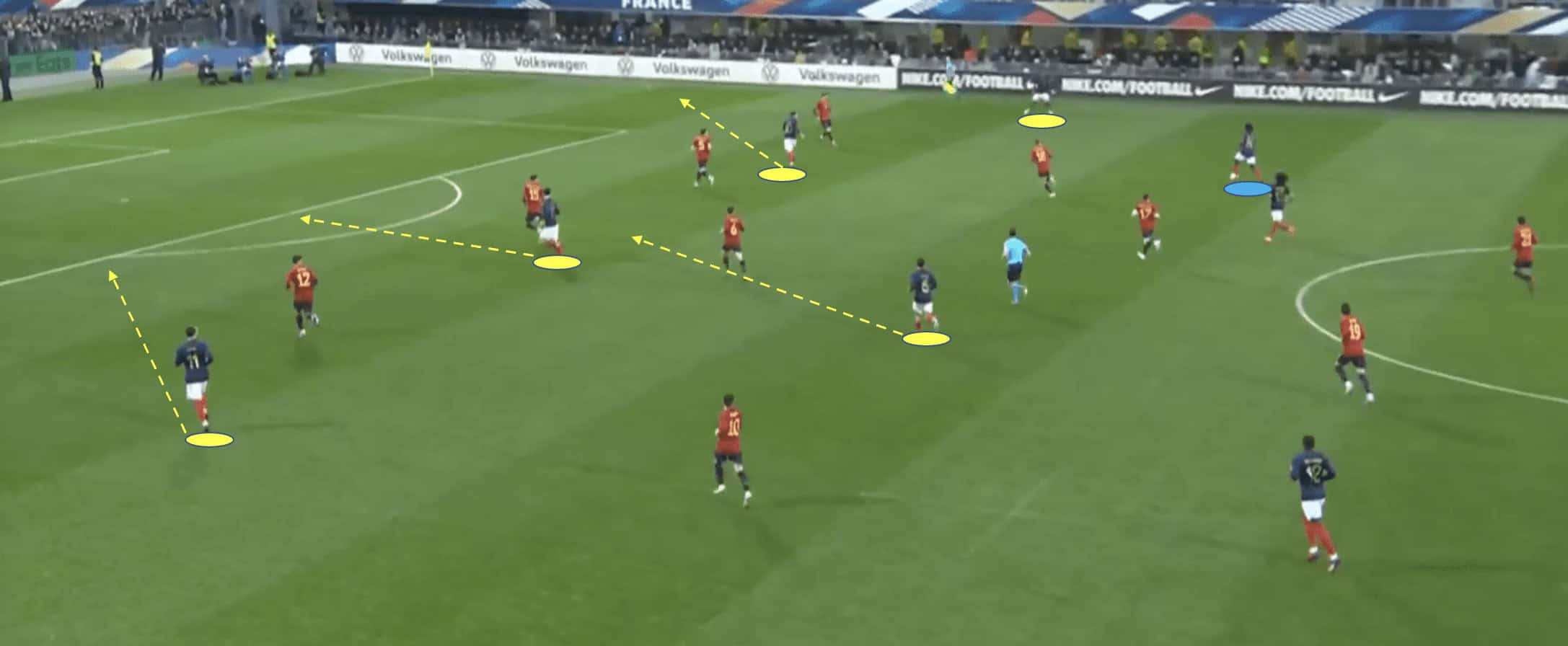
When France are approaching the opposition penalty area, they look to force the opposition into a low block. They do this by encouraging as many players forward as possible. As we can see in this example, France are in possession and have a multitude of runners available. Gouiri and Matthis Abline are looking to run into the penalty area whilst Rayan Cherki is looking to run in between the full-back and centre-back in order to offer a passing outlet in the wide-area alongside the France fullback.
Les Bleuets mostly look to get the ball out to the wide areas as often as possible in order to create plenty of space in the central areas. This means they can take advantage of the attacking prowess within their midfield who constantly look to join the attack.
Defensive Phase
In this section, we will focus on how France set up in the defensive phase of play, we will analyse their defensive shape and look into their pressing strategy and how it affects their overall game.

The data visual shows us how well France performs in the defensive phase in terms of percentile ranks. We can see that Ripoll’s team are extremely reliable when it comes to winning their duels whether it be in the air or on the ground. We can also see that France are quite efficient in terms of their pressing and are particularly good at recovering the ball in the final third.

In the defensive phase, France primarily adopts a 4-4-2 shape as shown in the image above. There are a few reasons why Ripoll opts for this shape in the defensive phase, first and foremost, it provides a solid and compact structure that effectively covers the field. As we can see, the four defenders form a tight defensive line, while the midfield is nice and compact which denies the opposition any opportunity to play through the lines.
Secondly, the 4-4-2 shape allows for numerical superiority in defence. By having four defenders at the back, the team can easily handle two central strikers or wide attackers, ensuring there are always enough players to mark and challenge the opponents effectively.
Moreover, the 4-4-2 shape promotes a balanced defensive setup. We can see that the two banks of four provide excellent horizontal and vertical coverage, making it challenging for the opposition to find gaps or exploit weaknesses in the defensive line. The compactness of the formation also allows for quick shifting of players to close down passing lanes and limit the opponent’s options.
Furthermore, the 4-4-2 shape facilitates effective zonal marking. Each player has a specific area to cover, making it easier to maintain defensive discipline and prevent opponents from finding space between the lines. This zonal marking approach ensures that there are fewer individual marking errors and reduces the risk of losing track of opponents.
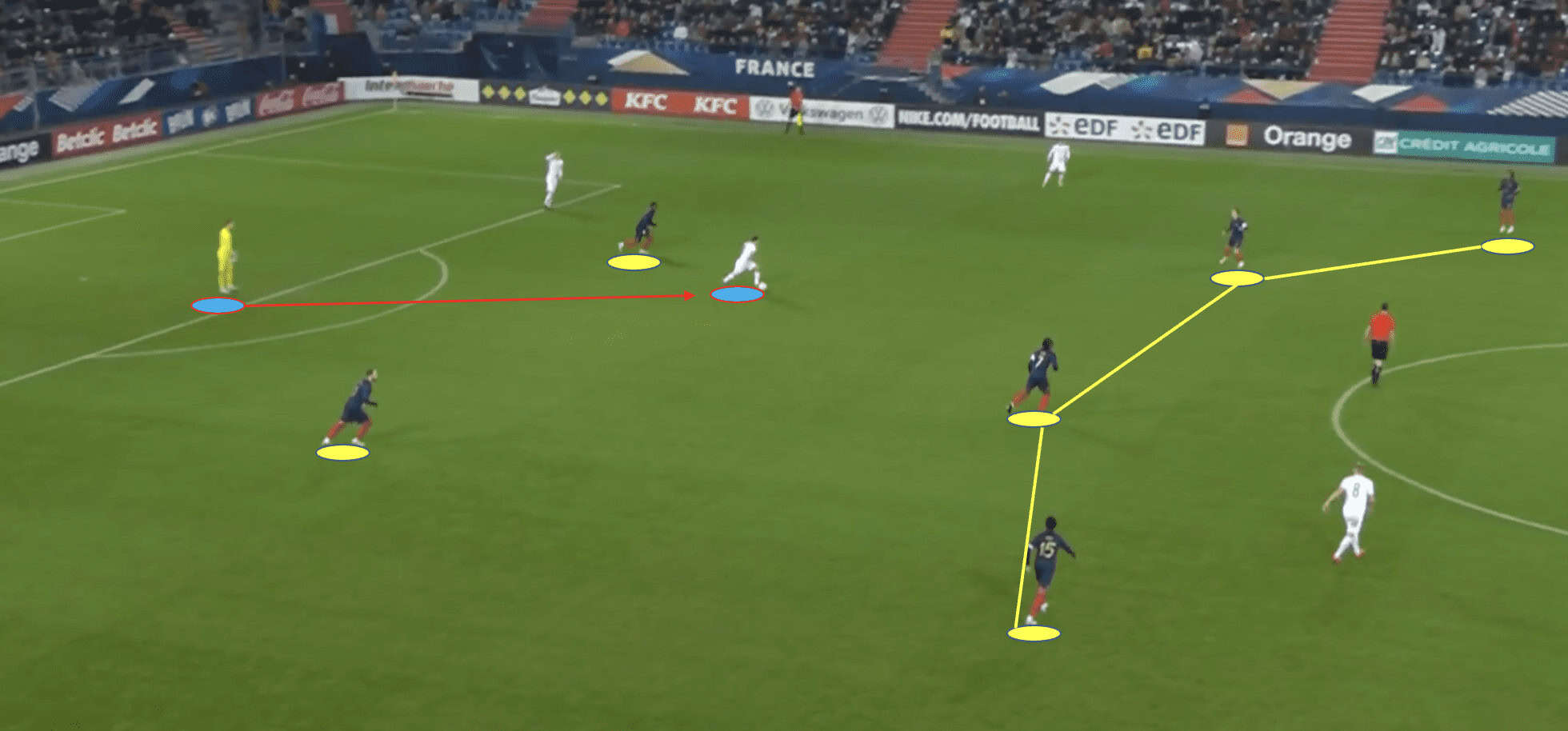
Here, we can see that despite lining up in a 4-4-1-1 formation, in the defensive phase it becomes a 4-4-2. Under Ripoll’s guidance, France U-21 have become much more adept at pressing. They have a PPDA of 9.38 — relative to others in the tournament, they are not exactly a ‘high pressing’ team, instead, it’s much more infrequent. France’s press can sometimes appear to be chaotic which presents the opposition with plenty of opportunities as we will discuss.
In the example above, we can see that the Norway goalkeeper has played a pass straight through the gap between the two forwards and the central defender has time and space to turn and travel with the ball.
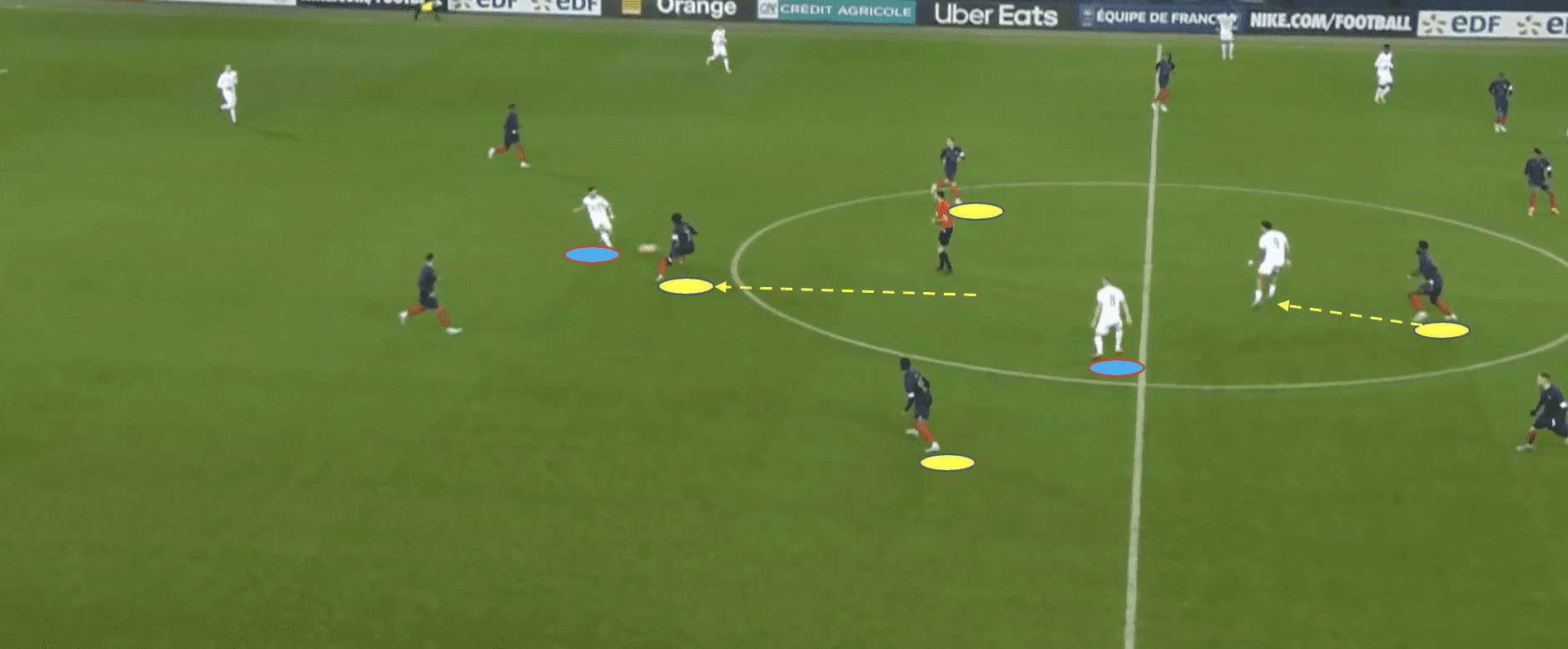
Here, in a continuation of the previous image, we can see that what happens next is that some defensive issues occur for France. Manu Koné steps out of the midfield block to try and press the player in possession, however, this is a poor decision as there are two Norwegian players available between the lines.
As a result of Koné stepping out to press, Badiashile then feels the need to step out of the defensive block and press the Norwegian forward. This leaves a huge gap in France’s defence as shown below. It also creates a dilemma for Mohamed Simakan as he is unsure whether to hold his position or cover the space left by his defensive partner.
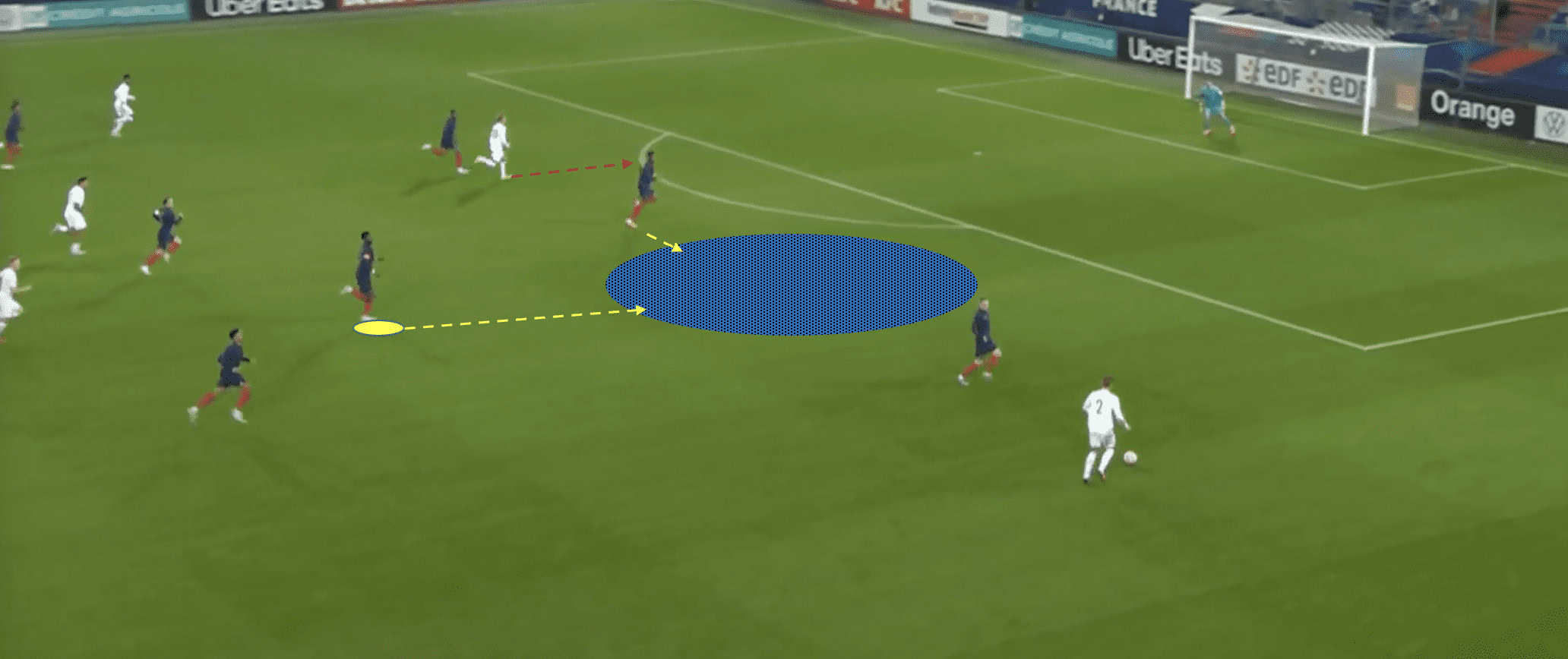
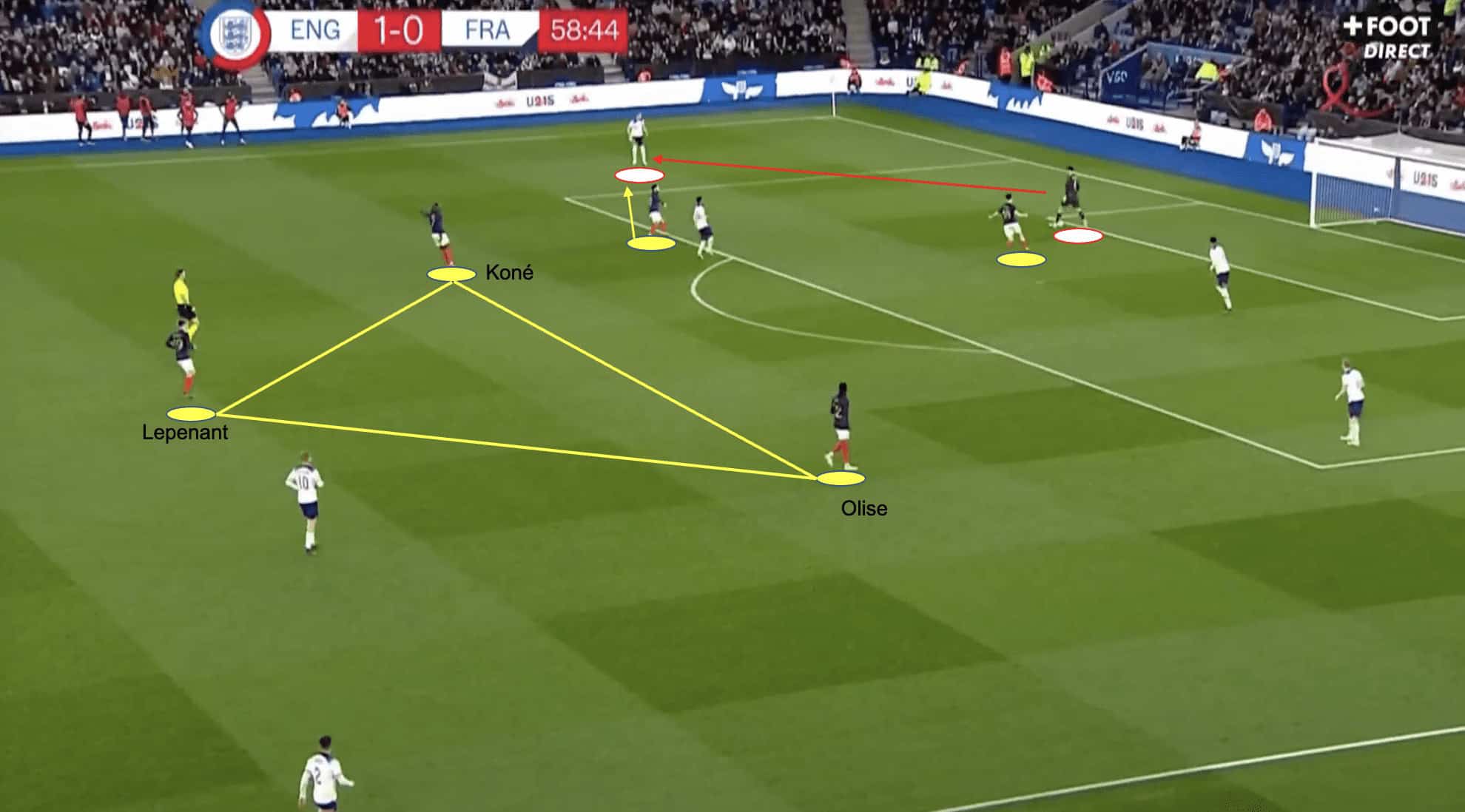
This example demonstrates France pressing in a much more methodical manner which has the desired effect. We can see the two forwards pressing the goalkeeper and the right back. Michael Olise and Koné have tucked in so that they can cut off passing lanes whilst Lepenant just stays back due to Emile Smith Rowe’s positioning. The press forces England to play a long ball which fails to reach its desired destination so they cede possession and France has the opportunity to build an attack.
Transition Phases
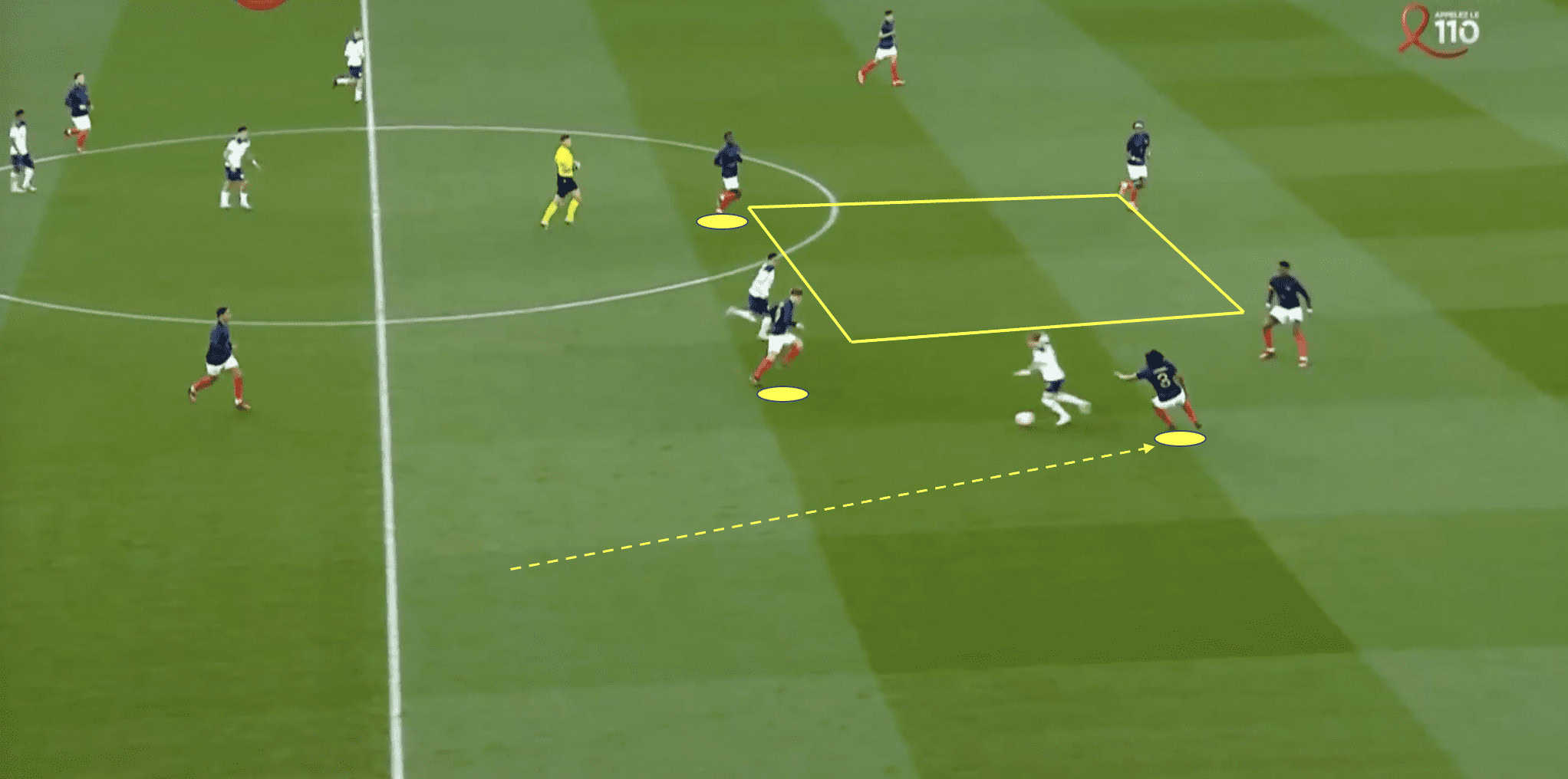
When they have lost the ball, France do look to initiate a press as soon as possible in order to recover possession. Additionally, they look to close the spaces at a rapid rate in order to prevent the opposition from being able to carve out any goal-scoring opportunities. As we can see in the image above, left-back Yasser Larouci immediately sprints back to ensure there is a back four in order to ensure that France always have a numerical advantage.
We can also see how Johann Lepenant and Koné have moved to close the space between themselves and the defensive line. This cuts off passing lanes and as a result, England are forced to play the ball backwards which then allows France to settle into their defensive structure.
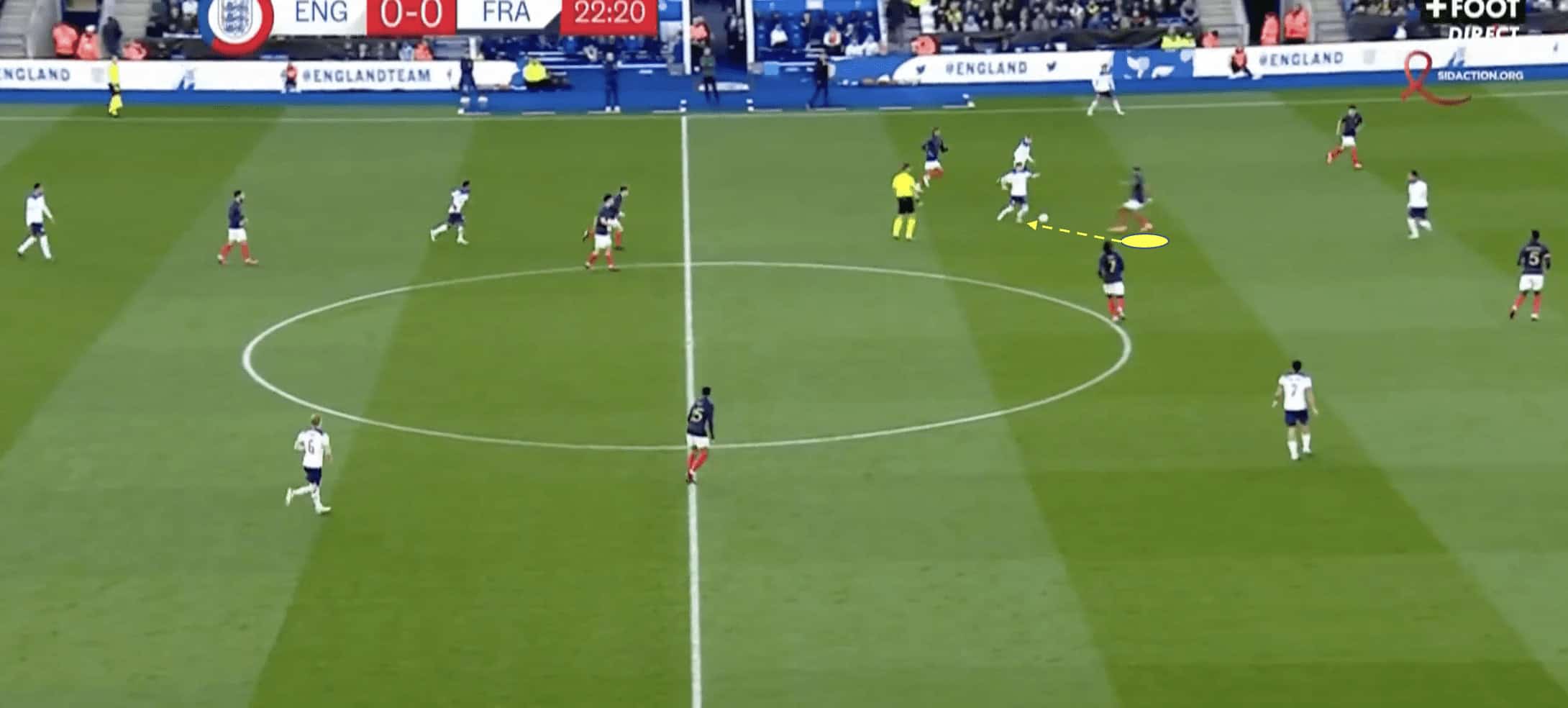
When France regains possession it is all about how quickly they can attack. Les Bleuets don’t like to give their opponents any opportunity to get back into their defensive shape. Here, we can see the defender is ready to step in to win possession back. When the defender wins the ball, there are four France players ahead of him so he always has a progressive passing outlet.

Possession has been won and as we can see in the image above, there’s no time for a considered approach, it’s all about being positive and driving forward at pace. Cherki is highlighted by the blue box, this is due to the fact that he is the furthest player forward.
This is a common aspect of Ripoll’s play, no matter what their tactical formation, France will always ensure there is one player who says reasonably high up the pitch in order to offer an attacking outlet for any counterattacks or long passes. This is also a way of ensuring the opposition are always wary of being ‘too’ attacking as their defenders always have to focus on the fact that the France forward can break through their line.
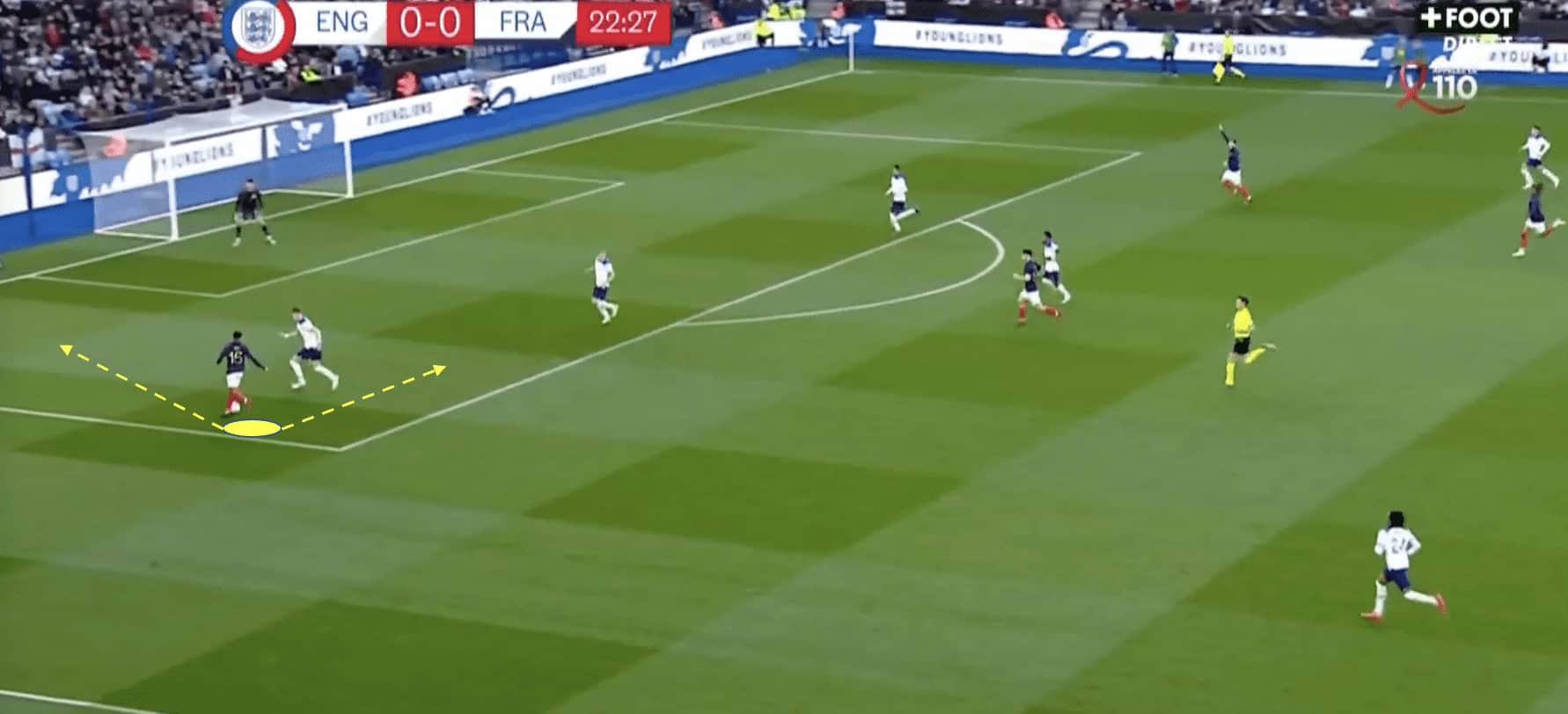
We can see here, there are seven seconds between France winning the ball back and them entering the England penalty area. Speedy transitions are particularly effective in counter-attacking situations as we can see. Quickly transitioning the ball forward allows the attacking team to capitalise on the disarray of the opposing team’s defence, catching them while they are unprepared and potentially leaving them outnumbered in the back.
Forwards
This France team is incredibly strong, particularly in the attacking positions. Gouiri has been touted as a potential star for a while now but has somewhat stuttered since leaving Lyon. He has averaged 0.35 goals per 90 for Rennes and was the top goalscorer for France in qualifying for this competition with five goals; however, he has failed to find the net for France U21 in the games that they have played over the course of the current season. Barcola is a player who has caught the eye over the course of this season playing for Lyon, Ripoll will likely seek to utilise his pace and ball-carrying ability by bringing him off the bench as the opposition begin to tire.
Cherki is a polarising figure, whilst many football fans rave about his talent, many believe that he has largely underperformed of late, but he did manage to chip in with four goals in qualification. Perhaps this tournament could be an opportunity for Cherki to reassert himself as one of the most talented players in this squad.
France’s attacking play is incredibly focused on their pace and ability to swiftly move the ball up the pitch. Amine Adli is key to this as he has excellent ball-carrying ability and wonderful off-the-ball movement which means it is incredibly difficult for defenders to track his runs.
Midfielders
Sylvain Ripoll is spoiled for choice in all areas but especially in midfield. There is the sought-after Manu Koné whose performances for Borussia Monchengladbach have seen him linked with a multitude of Premier League clubs. Koné’s positioning is often integral to France’s pressing, he is able to read the game extremely well and frequently ensures he is in the right place at the right time.
Moreover, Michael Olise has enjoyed some good form during Crystal Palace’s fight to remain in the Premier League. The versatile midfielder is in double figures for assists this season and can play in a multitude of positions. Maxence Caqueret hasn’t had the best season at Lyon but has been rather productive as he has eight assists to his name. The sought-after Joris Chotard and Johann Lepenant are more defensively-minded midfielders who Ripoll can count on to do the hard work in the central areas. Whilst Enzo Le Feé remains a shining star in terms of his creativity for Lorient this season.
Defenders
In terms of the defenders at Ripoll’s disposal, Lukeba and Fofana are most likely going to be his first-choice pairing. Castello Lukeba has been a shining light in a rather mediocre season for Lyon. Wesley Fofana has endured a tough season at Chelsea due to injury but he has fought his way back into the first team and could provide excellent leadership in Badiashile’s absence.
Meanwhile, Truffert and Gusto are both on the way back to full fitness after recent injuries so their inclusion is up for debate however, the former especially has been a regular starter under Ripoll so if he is fit, it’s likely he will be involved. Additionally, Quentin Merlin will be vying for a place in the squad as he has chipped in with three assists despite Nantes’ poor form this season.
Key Player
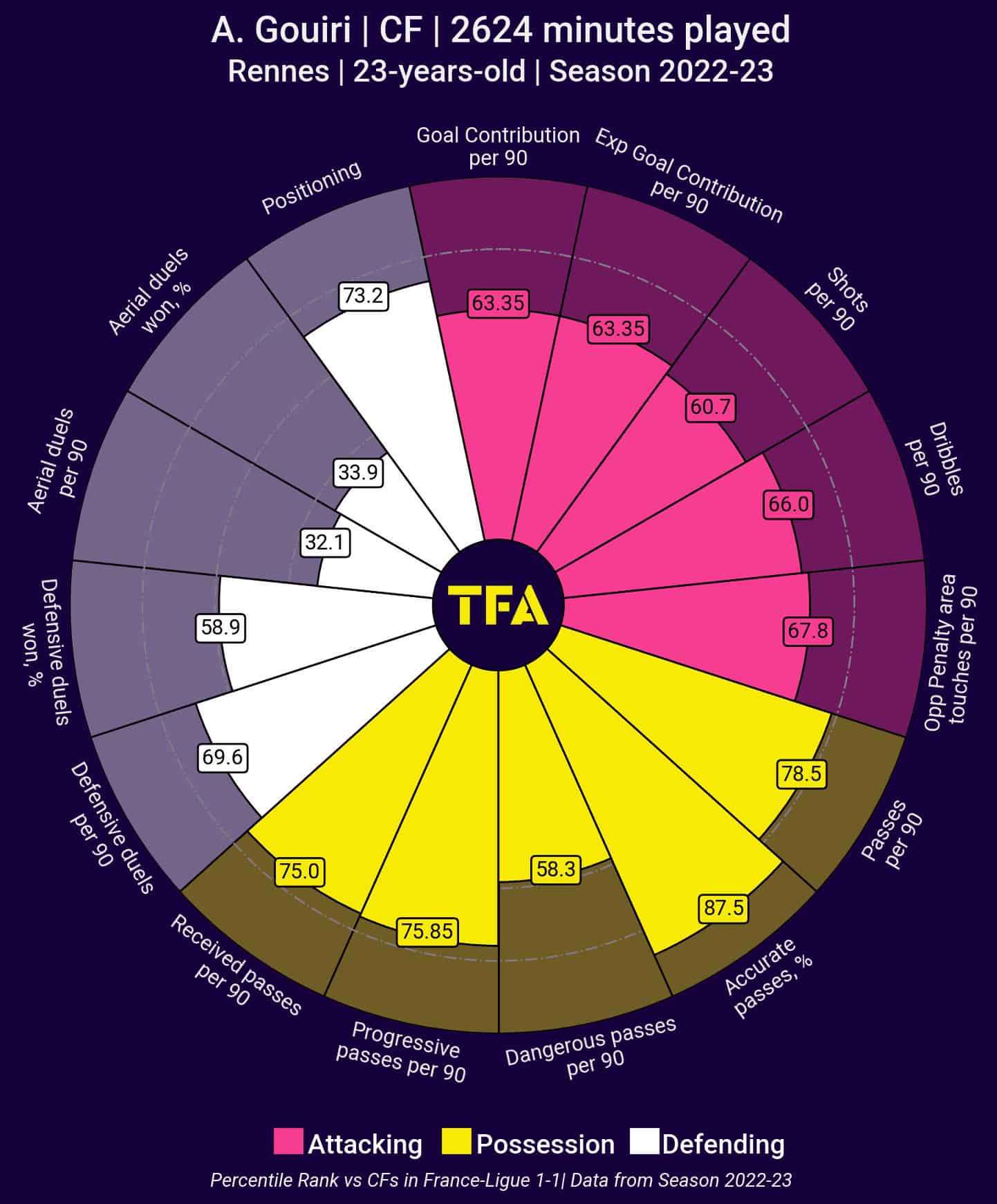
The data visual shows us how Amine Gouiri compares to his fellow Ligue 1 forwards this season. We can see that he is not the best in terms of aerial ability, hence why Ripoll is more likely to start him as a winger rather than a central striker.
Gouiri has enjoyed a good season at Rennes and will be looking to carry that into the Euros. He is very reliable in possession and opts to make progressive passes which move the play forward into the attacking third. Gouiri has scored 14 goals this season in all competitions and is someone that Sylvain Ripoll will be expecting to make plenty of goal contributions throughout the tournament.
Additionally, the Rennes man is willing to track back and work for the team, he is more than happy to engage in defensive duels as France will look to press in order to regain possession quickly.
Tournament Prediction
France has a strong chance of reaching the semi-finals or final of the U21 Euros based on their exceptional talent despite some poor recent performances. The team boasts a talented roster filled with promising young players who have showcased their abilities at both domestic and international levels. Their depth and quality across all positions give them a significant advantage over their opponents.
Furthermore, as we know, France has a proven track record of success in international competitions, with a rich history of producing top-notch young talents. Their emphasis on developing technical skills, tactical acumen, and a cohesive team dynamic gives them an edge over other teams in the tournament.
The team’s ability to control the midfield play is likely to be crucial in their quest for victory. Their attacking prowess, combined with clinical finishing and creative playmaking, should provide them with ample goal-scoring opportunities.
However, their group is not easy and Italy will present a very tough first game. If Les Bleuets can overcome a very strong Italian squad then it will give them a fantastic springboard for the games against Norway and Switzerland.
Overall, France’s talented squad, experienced manager, and strategic approach make them a force to be reckoned with in this tournament. With the quality of players available, France will be disappointed if they do not reach the semi-finals at a minimum.

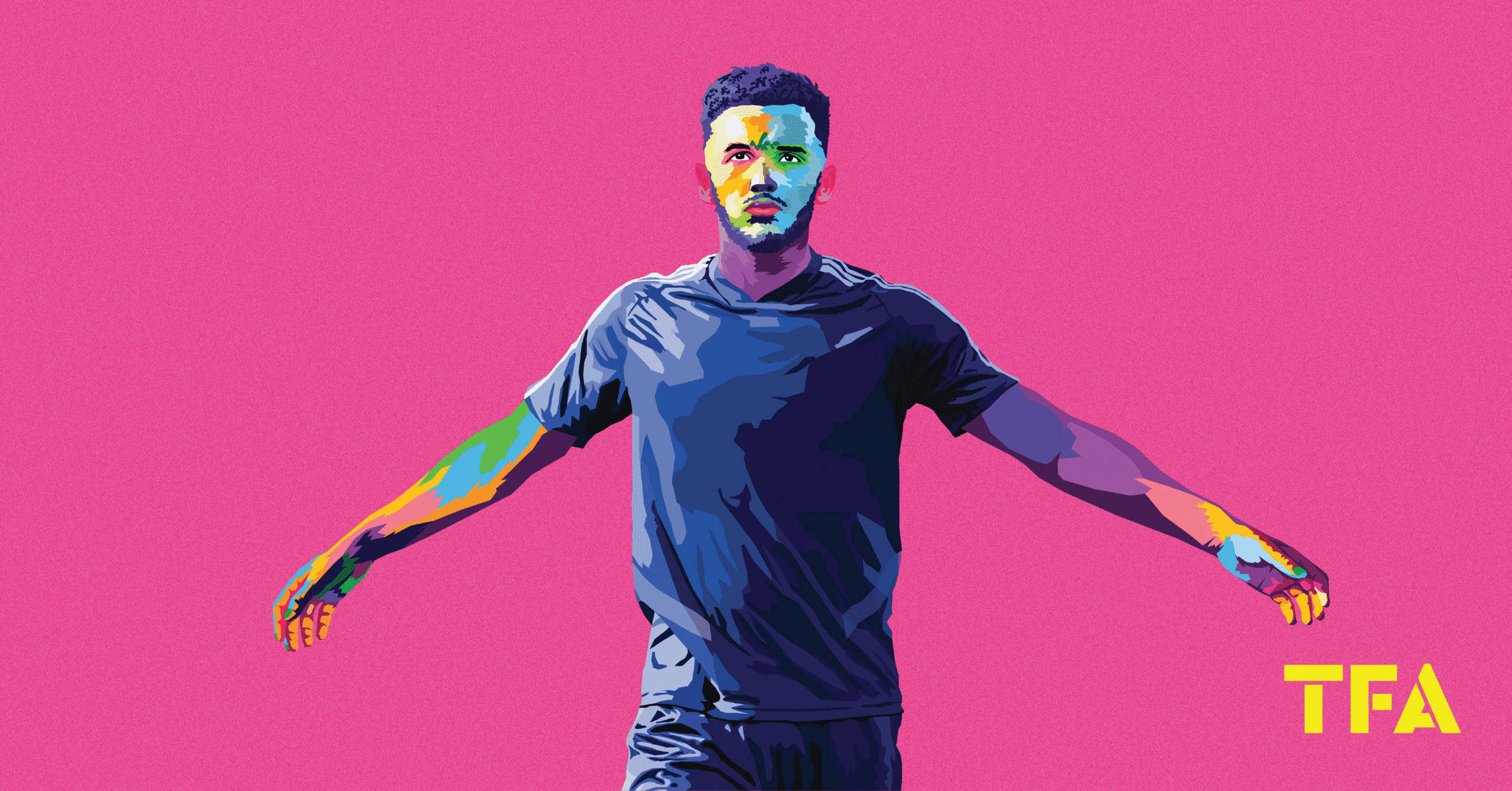



Comments